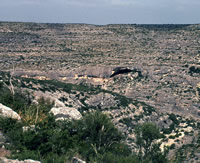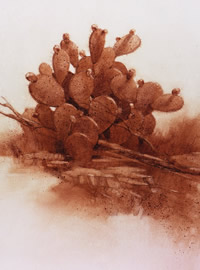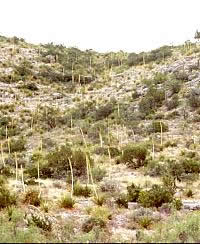Canyonlands Economy
By about 9,000 years ago (7,000 B.C.), if not earlier, the prehistoric inhabitants of the rugged canyonlands in the southwestern part of the region had developed a distinctive foraging or hunting and gathering economy based on a broad array of plants and animals. But it may not have been quite the idyllic “desert bounty” that some researchers have described. Life in the Lower Pecos Canyonlands was marginal, groups were small and nomadic, food was rarely plentiful, and surviving the lean season (winter to early spring) was an annual challenge. When rains came more regularly and heavily than usual, life could be good, but the canyonlands diet was very low fat, not much meat, and very, very high fiber.
Much of what we know comes from a very few well-studied places, especially Hinds Cave, the large, dry rockshelter on a side canyon of the lower Pecos River. Direct evidence of human diet from this site and others nearby comes from the coprolites, or preserved human feces, found in latrine areas within the dry rockshelters and in food refuse preserved in cooking areas. This evidence shows us exactly what they were eating—lots of arid-adapted plants, especially lechuguilla, prickly pear, and sotol, along with quite an assortment of fruits, nuts, rodents, rabbit, fish, and insects. The three plants that seemed to make up the bulk of the diet were baked in earth ovens. Deer were the largest and most desirable animal prey (bison were rarely present in the region after 9,000 B.C.), but big game hunting success was probably the exception rather than the rule. The most regularly eaten animals were rabbits and rats with lesser quantities of birds, lizards, snakes, and fish.
By Late Archaic times some 2,000 years ago, an even greater variety of plants were eaten, suggesting that need forced people to eat literally anything and everything they could acquire. Studies of human skeletal remains show evidence of regular dietary stress (periods of near starvation) and rotten teeth—the sugary baked plants caused cavities at rates as high as those experienced by more settled groups in the Southeastern United States who relied on maize (corn). Experimental studies show that a diet based heavily on baked xerophytic (arid-adapted) plants required a tremendous amount of effort relative to caloric return. Why work this hard for dinner? It seems clear that they had little choice—eat what was available, starve, or move elsewhere.
Be that as it may, the Lower Pecos Canyonlands were home to an essentially unbroken succesion of hunting and gathering peoples for over 8,000 years. Food may not have been bountiful most of the time, but the diet was obviously adequate. As archeologists like to put it, the lifestyle was well adapted to the canyonlands environment.
To learn more, see the Hinds Cave exhibit.


